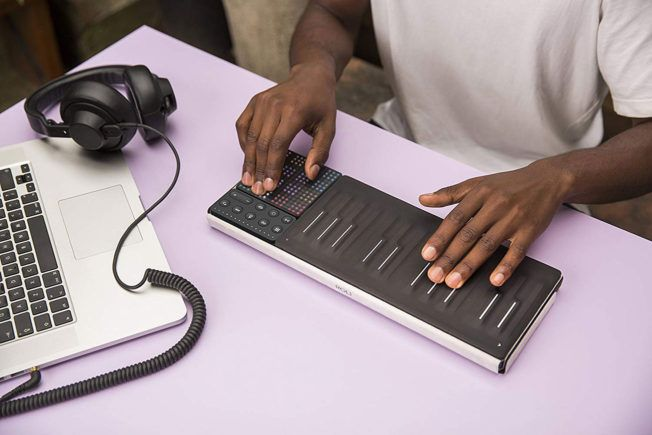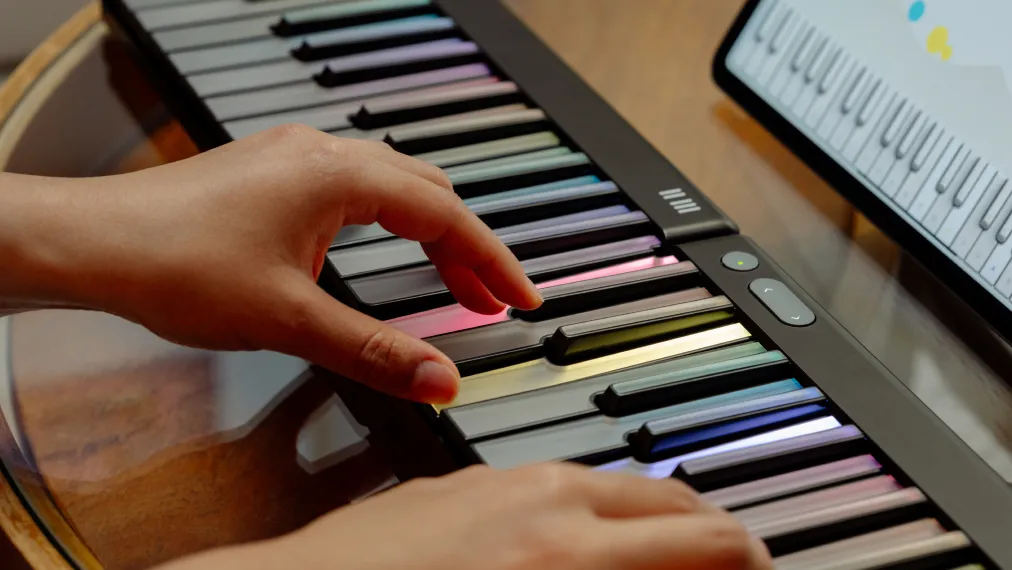
Travel changes how you practice. Hotel rooms, Airbnb living rooms, campus lounges, long weekends—none of them are built for an upright. That’s where a travel keyboard piano earns its keep. The right one fits in a backpack, sets up in seconds, plays quietly on headphones, and still feels musical enough to keep your fingers honest.
This practical guide shows you exactly how to choose a travel piano keyboard without overpaying or hauling something you won’t use. We’ll cover size, key feel, power, connectivity, and how to maintain momentum on the road. Along the way, you’ll see why a modular, light-up option makes a strong case as the best travel keyboard piano for most people who want both portability and progress.
A portable piano keyboard for travel has one job: remove excuses. If it’s so compact and quiet that you can play anywhere, you’ll actually practice. The checklist is simple:

Travel-sized doesn’t mean toy-sized. Pick key count by use case:
29–32 keys: Great for melody work, scales, chord drills, and learning with a lighted guide. The board stays small enough for a backpack or tote. With smart octave/transpose, you can cover surprising range. For pure travel, this is the sweet spot.
37–49 keys: More room for two-hand sketches and left-hand bass lines. Still manageable in a carry-on or slim case, but you’ll feel the size on a crowded train or when packing light.
61 keys and foldables: Best when you’re traveling by car or staying put for a while. Foldables collapse, but hinges add bulk and can feel uneven. If you’re a frequent flyer, smaller is saner.
When in doubt, start compact and add range later. A modular option that can attach an extra key section at home gives you the best of both worlds.
You don’t need heavy weighted keys to grow on the road. For travelers, responsive mini keys with decent velocity curves beat stiff, noisy action every time. Aim for:
If you plan to do two-hand pieces, make sure black-key spacing doesn’t pinch your fingers. Play a few scales and broken chords before you commit.
A travel piano keyboard lives or dies on power convenience. The best travel instruments turn on like a phone.
Every extra minute to set up is a minute you won’t practice. Test how quickly you can go from bag to first note.
You need two things: private sound and a way to save sketches.
If your keyboard offers guided lights or an app with visual note tracking, you’ll learn faster in unfamiliar spaces. That’s a serious advantage for busy adults who can only practice in small bursts.
A travel keyboard piano that looks minimalist on a product page often packs best because there’s less to break.

For many players, the best portable piano keyboard for travel blends compact keys with learning tools and a clear upgrade path. A small board with LED follow-lights lowers the barrier in noisy, distracting places.
A chord pad turns left-hand harmony into one tap so you can sing or sketch arrangements without hand gymnastics. If you can add a 24-key expansion at home, two-hand pieces no longer require a separate instrument.
That combination—tiny for travel, expandable for growth—makes a strong case for a modular, light-up smart keyboard as your top pick. It’s portable when you need it, and it doesn’t become obsolete when your skills outgrow the smallest form factor.
Road practice should be short, musical, and repeatable. Use this three-part flow anywhere:
Part 1 — Two minutes: unlock the hands
Gently flex wrists, then play a five-note scale pattern in today’s key. Keep volume low and tone even.
Part 2 — Eight minutes: chords + melody
Choose a four-chord loop (I–V–vi–IV works in most pop). If you have a chord pad, tap changes on the beat; if not, play whole-note roots. On top, place a two-bar melody you can hum. Loop the phrase at a slow tempo. If your keyboard has lighted guidance, follow the lights once, then switch them off and replay by ear.
Part 3 — Five minutes: record a snapshot
Capture a 16-bar loop into your phone, tablet, or laptop. Don’t chase perfection; chase momentum. Label the file with the city and date so you remember the trip.
That’s fifteen minutes, tops. It’s also enough to keep your technique and ear tuned while you travel.
If you’re worried about noise, play over white noise from a phone app at low volume. Your neighbors will only hear the hiss.

Slip the board into a soft sleeve, then align it along the back panel of your backpack where the laptop sits; keep books or a hoodie between the keys and any hard edges. Coil a short USB-C cable and a pair of wired earbuds into a side pouch. If you carry a power bank, test that it can run your keyboard for at least an hour.
On flights, consider placing the keyboard under the seat with the keys toward your shins. There’s less foot pressure there, and you won’t have to open overhead bins to grab it.
If this is you, either select a slim 37–49-key board or go modular—travel compact, add keys when you’re back. A foldable model can work for long trips, but test the hinge feel before buying.
If your goal is to balance portability, learning, and future growth, a small smart keyboard with LED follow-lights, one-tap chords, and an optional expansion makes travel practice effortless and home practice scalable. It’s the kind of instrument you’ll use on a plane tray table and still lean on when arranging at your desk.
They’re different, not damaging. Keep wrists neutral, play lightly, and run slow scales. Your accuracy transfers fine when you return to larger keys.
For practice and sketching, yes. For strict timing or tight DAW work, plug in via USB-MIDI.
Absolutely. Use guided lights or an app to break songs into 2–4-bar chunks. Record a rough take before you pack up each day.
For travel, 29–32 works surprisingly well. If you practice two-handed repertoire, step to 37–49 or add an expansion at home.
A compact, lightweight pedal is enough for phrasing practice. Many travelers skip it and focus on finger legato to keep luggage light.
The best travel keyboard piano is the one you’ll carry without thinking and play without friction. Choose compact keys that feel consistent, quick power and connection, quiet practice with headphones, and a path to grow when you’re back home.
If you want the most flexible setup, a modular, light-up smart keyboard is hard to beat: small in transit, confident in a hotel room, and expandable when your practice needs more range.
Set it on the desk, plug in once, and let short daily sessions add up. Travel doesn’t have to pause your piano journey—it can accelerate it.
Read more

7 Smallest MIDI Keyboards – Portable Yet Potent Mini Controllers!
If you make music on the move, a portable keyboard MIDI controller is the easiest way to capture ideas anywhere—on the couch, on a train, in a dorm, or at a tiny desk squeezed between a laptop and ...

Best Budget Keyboard Piano: Affordable Options in 2025
If you’re hunting for the best budget keyboard piano, you’re probably balancing three things: price, playability, and how quickly you can sound like you’re actually making music. Good news—2025 has...